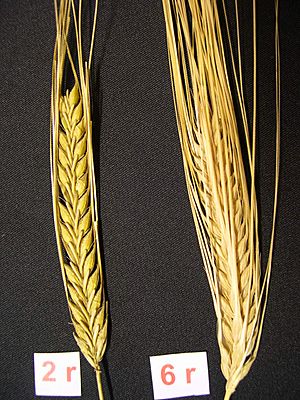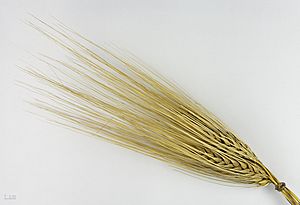Bere (grain) facts for kids

Bere, pronounced "bear," is a special type of barley. It is mostly grown on small farms in Orkney, Scotland. You can also find it in Shetland, Caithness, and on some crofter farms in the Western Isles. These islands include North Uist, Benbecula, South Uist, Islay, and Barra. Bere is probably Britain's oldest cereal grain that people still grow today.
Bere is a type of plant that has naturally adapted to its local area. It grows well in certain soils and in places with short growing seasons. It also likes long hours of daylight, which you find in northern Scotland. Farmers plant bere in the spring and harvest it in the summer. It grows very quickly, so it's often the first crop ready to pick. Locals sometimes call it "the 90-day barley" because it grows so fast!
Contents
What Does "Bere" Mean?
The word bere (or beir or bear) used to be a general Scottish word for any kind of barley. It comes from the Old English word bere, which also meant "barley." This word was used all over Scotland. Now, it's mostly used in northern Scotland.
Sometimes, bere referred to barley that didn't produce as much grain. For example, the phrase "bear meal marriage" meant a marriage that wouldn't bring much wealth. Professor T.C. Smout wrote that Scotland didn't have as many different crops as England. Often, Scottish farms only grew oats or bear (which was a simple type of barley).
A Look Back: The History of Bere
Bere is a very old grain. People might have been growing it in Britain since the Stone Age. Another old name for it was "bygge" or "big." This name probably came from bygg, the Old Norse word for barley. Over many generations, farmers in northern Britain kept growing bere. They chose the best plants each year to get seeds for the next year. This helped bere adapt perfectly to the northern climate.
In the 1800s and early 1900s, bere was a very important crop in the Highlands and Islands of Scotland. It provided grain for milling into flour and for malting to make drinks. The straw was used for thatching roofs and for animal bedding. Bere was even sent from Orkney and other Scottish ports to countries in Northern Europe.
However, new types of barley came along that produced much more grain. This caused bere growing to decline a lot in the 19th and 20th centuries. Luckily, bere is still grown today thanks to Barony Mills. This old 19th-century watermill buys the grain to make beremeal. This special flour is used locally to make bread, biscuits, and the traditional beremeal bannock.
Modern Research on Bere
Since 2002, the Agronomy Institute at Orkney College UHI in Scotland has been studying bere. Their goal is to find new uses for the crop. They also want to find the best ways to grow it more easily and get bigger harvests. Because of this research, bere from Orkney is now used to make whisky, beer, and biscuits. Bere is also being grown on the island of Islay to make whisky at the Bruichladdich Distillery.
Scientists at the James Hutton Institute have also studied bere. They found that bere is very good at growing in certain soils. These soils might have low levels of important metals like manganese. Bere can use manganese very well, even when there isn't much of it, like in the Orkney Islands. Bere is also strong against a plant disease called scald. It can also handle salty conditions. Bere flour is also known to have good levels of folate, which is a healthy vitamin.
Bere in Drinks
Bere has been used to make drinks for a very long time. Records from the 1400s show that Orkney made a lot of malt and beer. Most of this was probably made from bere. Even today, there's an old tradition of making homemade bere-based drinks on the island. In the 1800s, distilleries in Campbeltown used a lot of bere to make Scotch whisky. In the early 2000s, some whisky makers started trying bere again. In 2006, the most northern brewery in the UK even made a special beer using bere.




